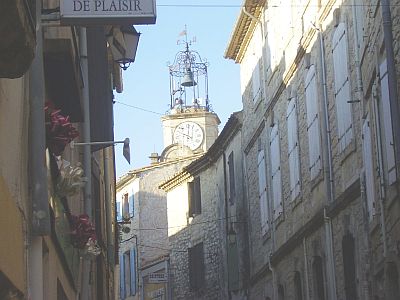 |
My Languedoc villageCalvisson (30420)
Introduction : Calvisson is a village of 4000 inhabitants which, despite it's population growth, has preserved the quaintness of its medieval heart. Location : Calvisson is ideally located in the Vaunage Plain 18 kms from Nimes and 40 kms from Montpellier. It is some 10 minutes away from the A9 motorway (exit 26). Thanks to the TGV (high speed train) the village is only 3h20 away from Paris. A tiny stream, L’Escatte runs through the village and several springs still feed today the fountains and washing pools. Thanks to its elevated position, Calvisson escapes the frequent and damaging autumn floods. The commune of Calvisson also includes the Sinsans and Bizac hamlets. Calvisson has joined the Communauté des communes du pays de Sommières. History : Two important personalities shaped Calvisson’s past. The first was Guillaume de Nogaret who was the chief counsellor of the French King, Philip the Fair. With his blessing, Nogaret masterminded the downfall, trial and burning at the stake of the Templars (1314). Legend has it that during a quarrel between the Holy See and Philip, Nogaret slapped the face of the Pope. In 1304, he was knighted and given Calvisson as a fiefdom. Until its destruction during the religious wars of the 16th century, the Nogaret castle provided protection to the village. The 200 hundred years long skirmishes between the Protestants and the Catholics created havoc in the region. As a result, and until the end of the religious turmoil in the middle of the 18th century, Calvisson changed hands several times. The second personality was Jean Cavalier. In 1704, with his Protestant militia known as the Camisards, he took refuge in the village before being defeated by the troops of the Sun King, Louis XIV. However Calvisson’s history dates back to Prehistoric times, and several burial places have been identified. The village is known to have played an important economic part during the Roman colonisation of the Vaunage. During the 19th century, peace brought economic prosperity to the village. As a result, several architectural landmarks including the town hall and the covered market were built. Both the Catholic and Protestant churches were rebuilt. Wind mills were erected on the hill, the Roc de Gachonne above Calvisson. They have been recently restored and have become tourist landmarks. Economy : Since the 19th century, and like most of the neighbouring villages, Calvisson’s economy has been dominated by the wine making industry. Its wine cooperative is one of the most active and innovative of the region. However, thanks to its ideally suited location, Calvisson has been able to diversify away from wine monopoly. Many residents commute to either Nimes or Montpellier, and population growth has fueled a thriving service industry. Calvisson offers all basic services. It has daily bus services to Nimes. There are petrol stations and garages for car repair, bike rental, hardware store, chemist, doctor’s offices, banks, cafes and restaurants, bed & breakfast, post office, real estate and insurance agencies, news stands and tabac, a supermarket, a butcher and several bakeries. A police station (gendarmerie) is also located in Calvisson. Village life : The inhabitants including the “expat” community have access to several recreational clubs, an outdoor swimming pool, and a music school. There is a kindergarten, primary and secondary schools. In summer, the active bull club participates in the organization of the village festival. The vibrant Sunday market attracts people from all over the region. Every Friday in summer, concerts take place in the covered market. Finally Calvisson is host to the Musée du Boutis (Provencal quilted needle work). Beatrice Labonne, August 2006.
A series of articles by residents describing their towns and villages. Why not add yours ? |
|---|
![]()


